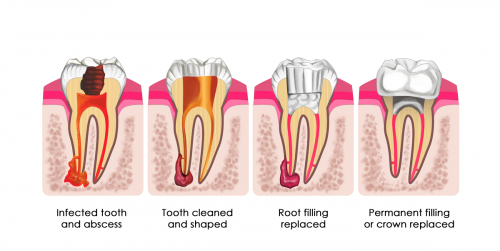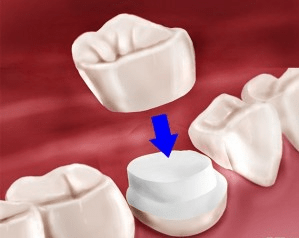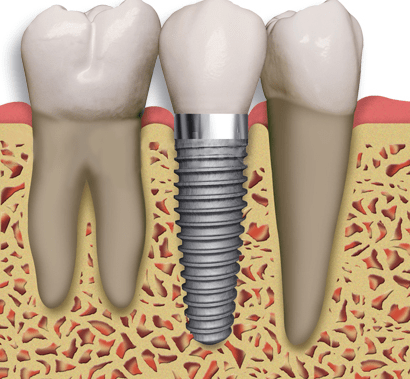Here at Dentalspa we take a conservative approach to dentistry with the aim to avoid tooth loss and keep your smile happy and healthy throughout your lifetime. Sometimes our Dentist’ will recommend treatments in order to extend the longevity of your tooth with the aim of maintaining lifelong oral health and reduce the amount of restorative work required in the future. There are more options available to you than a filling or extraction. Below we explain Root canal, Crown and Implant procedures in a simple matter in order to help you understand your options and indications for such work.
Root canal therapy.
A root canal treatment is generally indicated on a tooth when the pulp (nerve and blood supply) of the tooth is inflamed, infected or dead. In order to prevent or remove infection from the tooth the pulp is removed, the area is cleaned and dressed with medication and finally filled. This process occurs over a series of appointments in order to ensure complete removal of infection/inflamed tissue. A tooth which has been root canal treated is generally at high risk of breakage as the internal structures have been removed and therefore be
comes brittle. It is likely that a crown would be recommended by your dentist following a tooth which has had a root canal treatment to act as a helmet and prevent the tooth from fracture. Crown.
Crown.
 A dental crown is a restoration which is constructed by a dental technician and encases the entirety of the tooth. They are generally indicated to restore a fractured tooth, protect a weakened tooth from fracture, large fillings with little tooth structure remaining, add strength to a root canal treated tooth, placed over the top of an implant and address aesthetic concerns. For a crown to be placed it takes generally 2 appointments one where the tooth is prepared and impressions taken for construction and the other for the crown placement and ensure adequate fit. Not only does a crown provided added strength to a weakened tooth, they can also be used to improve appearance, shape and alignment of the teeth.
A dental crown is a restoration which is constructed by a dental technician and encases the entirety of the tooth. They are generally indicated to restore a fractured tooth, protect a weakened tooth from fracture, large fillings with little tooth structure remaining, add strength to a root canal treated tooth, placed over the top of an implant and address aesthetic concerns. For a crown to be placed it takes generally 2 appointments one where the tooth is prepared and impressions taken for construction and the other for the crown placement and ensure adequate fit. Not only does a crown provided added strength to a weakened tooth, they can also be used to improve appearance, shape and alignment of the teeth.
Implants.
A dental implant is a titanium post which is surgically positioned into the bone below the gum to allow a prosthetic tooth (crown) to be placed in that area. The titanium screw acts as the tooth root and can take a few months to be integrated into the surrounding bone and tissue. After integration of the bone a replacement tooth can be constructed similarly to a crown. Implants can help to restore function of the missing tooth/teeth and restore confidence in your smile. Implants can also help to prevent further implications and unwanted movement of the surrounding teeth.
If you have any further questions regarding the following treatments feel free to discuss these options with one of dental professionals here at Dentalspa Geelong.
By Ashleigh Lilly
Return to blog

